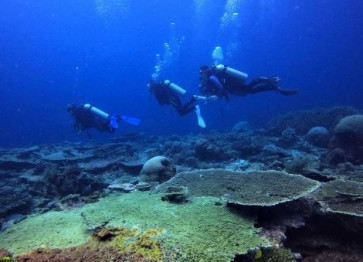The ocean is not just a carbon sink
Long outdated is the notion of the ocean as the planet’s greatest “carbon sink”, as are the climate strategies associated with that perceived construct; rather, our oceans must be at the heart of global mitigation efforts, as they already are in the food security, cultural identity and economic resilience of coastal communities everywhere.
Change text size
Gift Premium Articles
to Anyone
 Divers explore a coral reef on Sept. 7, 2023, in the Tomia Sea in Wakatobi, Southeast Sulawesi. (Antara/Jojon)
Divers explore a coral reef on Sept. 7, 2023, in the Tomia Sea in Wakatobi, Southeast Sulawesi. (Antara/Jojon)
T
his week, governments and civil society organizations from around the world gather in Nice, France, for the United Nations Ocean Conference (UNOC). The third such meeting since 2017, the conference comes at a time when countries are also finalizing their updated Nationally Determined Contributions (NDCs), or decarbonization plans, as required under the Paris climate agreement.
The timing is fitting, because changes in our oceans have become a familiar barometer for the severity of the climate crisis. Vibrant, Technicolor coral reefs, once bursting with life, are being bleached ghostly pale by warming, acidic waters. Island populations, such as the inhabitants of the largest of Panama’s Cartí Islands, are being forced to abandon their homes in the face of rising sea levels. And many coastal communities, often some of the poorest in the world, are being ravaged by increasingly severe cyclones.
As the ones on the front line, small island developing states are also leading sources of climate innovation. We have become test beds for solutions that can guide action globally. From our perspective, the ocean is not just a symptom of a changing climate, but also a major part of the solution.
The High Level Panel for a Sustainable Ocean Economy, of which the Seychelles is a member, estimates that some 35 percent of the emissions reductions needed by 2050 could come from the ocean. Most of this potential lies in industrial sectors, from decarbonized shipping to marine-based renewable energy. But the protection and restoration of certain “blue carbon ecosystems”, such as mangroves, seagrasses, saltmarshes, can also measurably contribute to climate change mitigation efforts.
In our own 2021 NDC, the Seychelles committed to mapping and subsequently protecting all seagrasses by 2030 across our exclusive economic zone, which totals 1.3 million square kilometers. Now, I am proud to say that we have already met that goal, protecting over 99 percent of our seagrass meadows five years ahead of schedule. In doing so, we have set a benchmark for ocean-climate leadership.
Other countries across the Western Indian Ocean are now undertaking similar work and outlining their own ambitions for the 2025 NDC updates.
In addition to serving as a measurable source of carbon storage, these ecosystems are some of the most effective and cost-efficient forms of natural infrastructure available for stabilizing shorelines and buffering storms. They provide a vital first line of defense for islanders and coastal dwellers, absorbing wave energy, filtering water and preventing erosion. And they also underpin the blue economy on which billions of livelihoods depend.


















